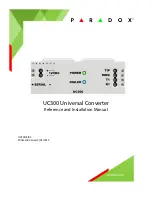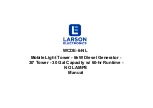
User Manual
EM303A General Purpose Inverter
126
acceleration time of motor is longer than the setting time. Check if the setting
current limit of inverter is excessively low.
z
If the setting acceleration time is too long, confirm its parameters.
9.2.4
Excessively Long Deceleration Time
z
When dynamic brake enabled
The brake resistance is too big. The dynamic brake power is too small, so the
deceleration time is prolonged.
The setting value (FC-16) of brake duty ratio is too small, and the
deceleration time is prolonged. Increase the setting value of brake duty ratio.
The setting deceleration time is too long, confirm its parameters.
z
When overvoltage stall protection enabled
Overvoltage stall protection acts, when DC bus voltage exceeds DC690V, the
output frequency remains unchanged. When it is below DC660V, the output
frequency drops continuously, therefore the deceleration time is prolonged.
The setting deceleration time is too long, please check its parameters.
9.2.5
Inverter Overheating
z
Excessively heavy load
Heavy load makes inverter work beyond its rated current for a long time. The
power of inverter shall be applicable to that of motor.
The motor rotor is blocked due to the failure of motor or load.
z
Excessively high ambient temperature
When the ambient temperature of inverter exceeds the permitted value, the
temperature might exceed the permitted highest value of inverter when it works
in the rated status.
9.2.6
Electromagnetic Interference (EMI) and Radio-frequency Interference
(RFI)
z
When inverter runs in high frequency switch status, it will generate EMI and
RFI on the control devices. Take following countermeasures:
Lower the carrier frequency (F0-14) of inverter.
Install noise filter on input side of inverter.
Install noise filter on output side of inverter.
Shield cable with a metal tube, and place the inverter in a metal case.
Reliable grounding for the inverter and motor.
The main circuit and the control circuit should be separated in terms of
wiring. Control circuit should take shielded wire, and see Chapter 3 for
wiring.














































